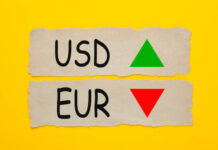USD – Rate hikes on the way
The greenback had displayed notable strengthening in 2021 and in December the currency managed to stabilize at higher grounds. According to the Dollar Index that follows the USD’s course against other major currencies, the stabilization at higher grounds may be proof that the economy has improved, despite the well-known difficulties that are still present. Looking at the Dollar Index we may notice some technical barriers especially to the way up, as the currency seems to have reached yearly highs in the previous months and corrected lower implying traders are keeping their positions but may be hesitant to increase them for now. Most of the market’s focus is currently placed on the Federal Reserve, as it has pointed out it plans to make significant changes to its monetary policy as soon as the coming months. Rate hikes are already considered yet we cannot guarantee when exactly they will be imposed while the percentage of the rate increase should also be kept in mind by traders. If the rate is increased by a wider margin than expected this scenario could send a different message to market participants and the global economy. Among the top indicators of the US economy we start with the housing market that continues to be on the rise with the Housing Starts Number and Existing Home Sales figures for November being on the rise. The New Home Sales-Units stabilized at previous months levels. Moving to the Job market that according to the Unemployment rate continuous to drop consecutively since June now reaching 4.2%. If the trend continues then we will soon be seeing the rate dropping to pre pandemic levels. Yet the recent difficulties with the new variant may postpone such an outcome. Inflation which continues to be a major concern of the market presently continues to be on the rise as the yearly rate reached 6.8% in November. This indicator is among the most crucial concerns of the Fed that may prompt it to take action the soonest. We see the US economy continuing to improve and inflation stabilizing and possibly returning lower as rate hikes come into play. Supply chain issues may also retreat at that time, as manufacturing in Asia continues to improve currently.
EUR – Supply bottlenecks and higher energy prices
The Euro has been in a downfall for most of the previous year losing ground most notably against the USD and the GBP. From our point of view the EUR as a currency continues to move within a familiar range that was used since previous years. This in our opinion seems to display some stability for the currency even though at times it seems that the uncertainty over the Eurozone’s economic performance overshadows this positivity. In November the Eurozone’s final yearly HICP rates which reflect Inflation levels within the group, showed stabilization at 4.9%. The Eurozone’s Preliminary Consumer Confidence rate for December moved further into the negative area which may imply that the expectations for the economic recovery remain gloomy for the near future. The Preliminary Markit PMI readings for the Eurozone, Germany and France where lower in December yet we will have to wait for the final readings to confirm the drop. At the moment the market’s expectations for the ECB to make drastic changes in the New Year remain rather low. The European central bank is not expected to reduce its bond buying program until 2023 according to the Financial Times. That is also the time when the bank is expected to start increasing its interest rate. This could be an indication that the ECB may be using a more patient approach rather than the more aggressive driven strategy most other major central banks are using around the world. On a more optimistic note, the pandemic-response scheme, a program designed to enhance recovery in the zone could be ending in March as per ECB president Christine Lagarde. Finally referring to the largest economic power in the Eurozone, Germany, which has recently appointed Olaf Scholz as Germany’s new chancellor may be in for noteworthy changes. Scholz is gunning for a greener economy and climate change measures. Overall we see Europe still finding challenges to deal with supply bottlenecks and higher energy prices in the first quarter of 2022. Thereafter, these problems could subside possibly adding support to the Eurozone block.
GBP – In a confident position despite challenges
The pound managed to hold its ground against the USD in 2021 but finished the year lower, while it dominated the scene against the EUR. The move in our view tends to be positive for the UK economy which even though is still facing trouble with the pandemic and the Brexit front, it seems to be able to stand on its own feet until this moment. In October the UK unemployment rate fell to 4.2%. The unemployment rate in the UK has been dropping successively since May 2021 landing currently at 4.2% and this tends to support improving economic circumstances. UK Retail Sales in November increased and surpassed both prior and anticipated readings which is another awesome sign for the economy which seems to be expanding. Also, December Preliminary Markit PMI data failed to impress as Services and Manufacturing seemingly dropped. Manufacturing had stalled in October thus the economy could be losing its step in this sector for the time being. Yet the UK GDP yearly rate for Q3 rose which again counterbalances negative impact on Manufacturing. Moreover, UK Nationwide house prices rose both yearly and monthly in December, indicating the house market remains solid in the UK. Thus we could say rightfully the Bank of England increased it interest rate to 0.25% in its most recent meeting in December. December was a rather difficult month for the UK economy with a broad turn towards cancelations over the holiday season which took place after the new variant. Chancellor of exchequers Rishi Sunak then announce an extra 1 billion pounds for the businesses impacted from these circumstances which gave a temporary boost to the GBP. Overall we see the UK being in a rather confident position despite still facing uncertainty and possible instability over Brexit and high energy prices.
AUD and NZD – Commodity currencies in focus
The AUD has lost ground against the USD, NZD and the GBP in the past year. According to Australia’s GDP rates for Q3 the economy continues to shrink yet at a slower pace than initially forecasted. On the bright side the Australian unemployment rate is currently at 4.6% compared to 6.4% where it started in 2021. The Reserve bank of Australia currently keeps its interest rate at 0.10%. Many media sources like Bloomberg see pressure mounting for RBA in 2022 as the banks stimulus program may be obsolete in the coming months. It is also important to note that RBA Governor Phillip Lowe has confessed that his banks decisions have been influence by other major central banks across the world in the past thus they could be waiting to see further action from them to act in the future. In general, Australia has been challenged by a number of lockdowns in some parts of the country. Furthermore, the muted economic activity in China may have also impacted Australia in the past year and may continue to do so. On the other hand, New Zealand seems to be making its own decisions based on its own views. Unemployment is currently down to 3.4% a rather low figure compared to other major economies. The Reserve Bank of New Zealand has increase its interest rate to 0.75% even as GDP rates for Q3 both yearly and monthly have dipped into negative territory. The NZD has been lower against the USD but has gained ground against both the GBP and the EUR in past 12 months. In our opinion the New Zealand economy remains stronger as it has also been able to handle the pandemic more efficiently and with stricter measures.
CNH and JPY – Industrial output and Manufacturing in the scope
In China economic activity may be in slowdown for the past several months as it has been facing important challenges on the energy crunch front. This issue has been very difficult to handle and its output may have been limited in this case. Chinese inflation rates for November have increased to 2.3% yet somewhat optimistically the country’s industrial output has increased to 3.8%. The Chinese NBS Manufacturing PMI for December improved slightly and paired with the pre mentioned Industrial Output can be a positive sign for the global economy as supply bottlenecks difficulties can be on track to subside if these readings continue to improve. The Chinese Renminbi continues to strengthen against the USD and the EUR in the past 12 months. On a different note the Japanese economy seems to be managing to keep the negative economic impact at low levels compared to major economies. In November the unemployment rate was at 2.8%, the lowest among major economies while its CPI rates increased but remained below 1%. Very impressively, the Japanese Preliminary Industrial Output rate increased in November. Yet the increase was substantial jumping from previous 1.8% to current 7.2%. In the past year the JPY has been evidently weaker than the USD and the EUR as the cheaper JPY tends to support the country’s efforts for higher value on exports.
TRY – Instability tantalizing the Lira
Turkey and the Turkish Lira have been in the epicenter of the markets focus for the past months. The ongoing weakening of the TRY combined with higher inflation data seem to create severe challenges for the Turkish economy. The Central Bank of the Republic of Turkey seems to keep its strategy of reducing its interest rate lower and lower yet media sources are calling for a mass opposition from Turkish citizens and investors. In December Turkish monthly CPI rates have jumped from previous 3.51% to 13.58% which is unheard of. Please note the yearly rate also jumped to 36.08%. The Turkish Lira has been continuously weakening against the USD, GBP and the EUR for the past year. Recently Turkish President Recep Tayyip Erdoğan announced that new measures to support the economy would be imposed that created a short-lived comeback for the TRY. In our opinion, the TRY will continue to be driven by Turkey’s ambiguous economic performance and internal political tensions.














